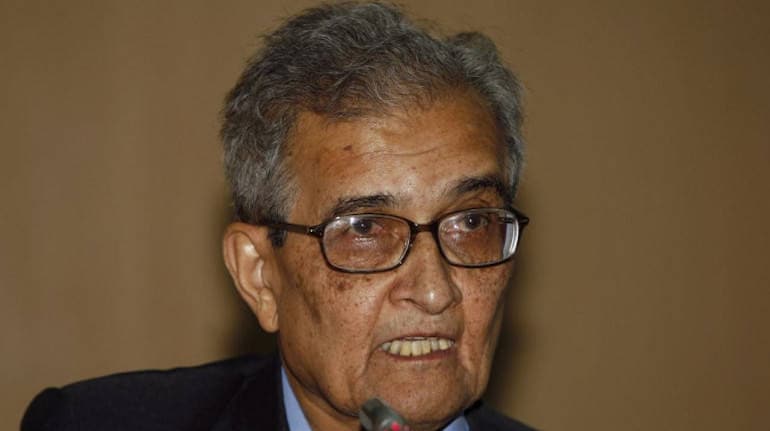Manas Chakravarty
Just before the general elections in 2014, a rather unlikely fight erupted in the pink papers. In the Left corner, wearing what some people said were bright red shorts, was Nobel Laureate and economist Amartya Sen. In the Right corner, wearing true blue shorts, was eminent trade economist Jagdish Bhagwati.
The dispute was whether social welfare and health and education were best served by rapid economic growth, which was the view from Bhagwati’s corner, or whether social equity and health and education lay the groundwork for rapid growth, which was Sen’s thesis.
These arguments became prominent in the context of the 2014 elections. The pundits said Narendra Modi stood for rapid growth, while the UPA was all about social welfare.
The UPA’s critics, who were legion, made Bhagwati their intellectual mascot and argued there could be no redistribution without rapid growth. Let India grow first, they said, by freeing markets and allowing the ‘animal spirits’ of entrepreneurs free rein and there would soon be a surplus that would trickle down to the masses. Go in for social welfare too soon, they added, and growth would falter, just as it had done under the UPA government.
It was a seductively logical argument and, truth be told, Sen didn’t have too much support at that time in a nation yearning for change. After all, inflation had spiked through the roof, there were corruption charges galore and Modi was a far more charismatic figure than anybody in the UPA. Best of all, Modi had the track record of the Gujarat model to back him up.
The Sen versus Bhagwati debate became the intellectual counterpart of the BJP versus UPA electoral battle. It became a right-wing versus left-wing fight. We all know who won it.
At that time, Sen’s arguments that beefing up India’s ramshackle school system and its rickety public health infrastructure should have top priority, rather than just economic growth, seemed like the ramblings of an academic mounted on his hobby horse. His concerns about expanding and safeguarding human capability were too abstruse for most people and he was decried as a populist.
Nobody paid much attention to his contention that the Asian miracle economies all emphasised literacy and education and healthcare, which served as a foundation for their high growth.
The BJP won the election and Narendra Modi became prime minister. Bhagwati continued to support the policies of the Modi government, including demonetisation.
Sen continued to criticise the government, pointing out in 2018 that India was heading towards a ‘comprehensive healthcare crisis’. Bhagwati, together with Arvind Panagariya, wrote a book, ‘Why Growth Matters’, explaining their position, while Sen and Jean Dreze wrote ‘An Uncertain Glory: India and Its Contradictions’, elucidating theirs. But the elections were over and the Sen vs Bhagwati debate faded into oblivion.
At the time of the debate, many economists had pointed out that the differences between the two economists were overblown and their positions were caricatures rather than the truth. Sen was hardly against growth, while Bhagwati wasn’t against welfare. But there is little doubt that the Modi government was, at least initially, taken in by its own rhetoric. Why else did Prime Minister Modi call the MGNREGA programme a ‘living monument of the Congress-led UPA’s failures’?
As time passed, the talk about a Gujarat model died a natural death. The Modi government continued with economic reforms, but went down the welfare road as well. That didn’t stop rural distress from increasing, small industries were badly hit by demonetisation and GST, the non-banking financial sector cratered, loan growth fell and unemployment went up. By 2019, economic growth had plummeted.
And then came the COVID-19 pandemic. Almost overnight, the public health system became the focus of attention everywhere. That government expenditure on health was less than 1 percent of GDP, lower than for poor countries such as Mali, Kenya and Mozambique, suddenly became a topic worthy of discussion. Why was the number of hospital beds per thousand people lower than, say, in Sri Lanka or in Vietnam? And why is average life expectancy at birth in India, with its much higher per capita income and higher growth rates, lower than in Bangladesh, as Sen had been pointing out for years?
Suddenly, we started remembering that hundreds of thousands of people die from tuberculosis every year in India, which has the highest number of such cases in the world. The Modi government rediscovered the virtues of MGNREGA. And the much derided Kerala model - the Prime Minister even compared the state to Somalia - shone in the limelight.
The lack of public health infrastructure is what has forced India into a series of lockdowns, the most stringent in the world. If we had better hospital facilities, more equipment, more beds, our policymakers now wouldn’t be facing difficult choices about easing lockdowns, especially as our mortality rates are low.
And finally, the lockdown has also riveted national attention to the sub-human conditions in which the urban poor live and their hand-to-mouth existence. Those world-beating high GDP growth rates don’t seem to have trickled down much.
Growth by itself doesn’t seem to be enough. After all, the World Bank, in its path-breaking report on the East Asian Miracle in 1993 had pointed out, ‘The HPAEs (High Performing Asian Economies) are unique in that they combine this rapid, sustained growth with highly equal income distributions.’
It had also added, ‘The research also further supports the desirability of a two-track approach to development policy emphasising macroeconomic stability on one hand and investments in people on the other.’
And further, ‘Investments in people, education, and health are legitimate roles for government in the neoclassical framework, and its adherents stress the importance of human capital in the HPAEs' success.’
The COVID-19 pandemic has hammered home Amartya Sen’s point.
(Do write in with your views on whether COVID-19 has borne out Amartya Sen’s warnings to Manas.Chakravarty@nw18.com)

No comments:
Post a Comment